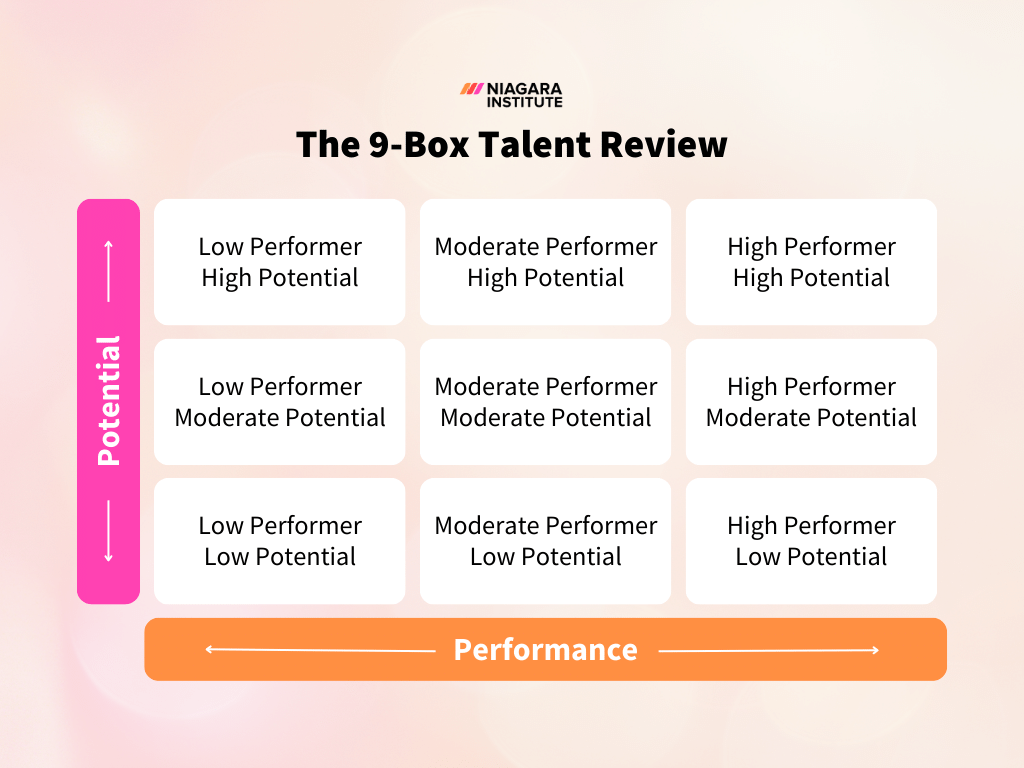6 min read
The Only Gap Analysis Template You’ll Ever Need (+Instructions)
In today’s workplace, staying static is not an option. If you fail to continuously improve everything from your performance to your team’s culture,...

If there’s one thing those in leadership, human resources, and talent management are always trying to do it’s evaluate their employee’s performance and potential. It’s why the 9-box talent review is as popular as it is.
While this assessment tool promises to help you evaluate your employee’s performance and potential, that’s not to say it doesn’t have flaws - because it does - and we’re going to discuss them, as well as answer the most frequently asked questions about the 9-box talent review in this article. Let’s get started.
A 9-box talent review is an assessment tool used in the workplace to categorize people based on their performance and potential. The intended purpose of this tool is to help people leaders and talent management professionals make decisions about their workforce and maximize the potential of their most valuable asset - their people. Here is an example of what a common 9-box talent review looks like:

The concept of the 9-box talent review is relatively straightforward. On the horizontal axis of a 3x3 grid, is a person’s current performance from lowest to highest. While on the vertical axis, a person’s potential for growth and success is plotted from lowest to highest. So to complete the 9-box talent review, you would consider the current state of a person’s performance and their level of potential and then put them into one of the nine corresponding boxes:
Once you have categorized a person (or group of people), the idea is that you will have a better idea of how to optimize time, energy, and resources. For example, theoretically, if you categorize someone as a moderate performer with high potential, you may be more likely to assign them stretch assignments, enroll them in training, or set up job shadowing over someone you categorize as a low performer with low potential.
If you’re thinking of the problems this may cause or the nuances in people management that this matrix does not account for, you’d be right to do so. The fact is that while the 9-box talent review is simple and straightforward in theory, in practice, it’s anything but. We’ll discuss the criticisms of the 9-box talent review in more detail below.
In order to complete a 9-box talent review, a series of questions must be asked in order to come to the conclusion that a person should be placed in one category over another. Here are a few example questions one might ask:
The 9-box talent review originally evolved from the GE-McKinsey nine-box matrix, which first appeared in the 1970s. In a 2008 article, McKinsey explained that the intended purpose of the original matrix was to “offer a systematic approach for organizations to determine where best to invest its cash. Rather than rely on each business unit's projections of its future prospects, the company can judge a unit by two factors that will determine whether it's going to do well in the future: the attractiveness of the relevant industry and the unit’s competitive strength within that industry.” Since then, those in human resources, talent management, and leadership have adapted it to meet their own needs, thus resulting in the 9-box talent review we know and use today.
Before you jump right to trying to complete a 9-box talent review of your own, it’s important to acknowledge some of the very real and valid criticisms that have caused many in leadership, human resources, and talent management to discontinue or, at least, limit its use.
First and foremost, the 9-box talent review disregards the nuances that make each and every person in the workplace unique and capable. In other words, it grossly oversimplifies people and reduces them to a single point on a grid, which, as we know, is anything but fair. When you evaluate people solely based on two things - performance and potential - you fail to capture the intricacies of their skills, strengths, experience, and developmental needs.
The next problem with the 9-box talent review is that it’s highly subjective in nature. Our biases, whether conscious or unconscious, can cause our personal preferences and relationships to have a greater bearing on the evaluation than they otherwise should. Not to mention, “potential,” one of only two factors the 9-box talent review takes into account, can mean something different to everyone. As the authors of one Harvard Business Review article noted, evaluations that hinge on ambiguous context and criteria are more likely to be biased. Here is why that is: “As many studies have shown, without structure, people are more likely to rely on gender, race, and other stereotypes when making decisions - instead of thoughtfully constructing assessments using agreed-upon processes and criteria that are consistently applied across all employees.”
If that’s not enough to make you question the fairness of the 9-box talent review, we’ll note one final criticism. When the 9-box talent review is used behind the scenes in secret, and people don’t know about it, the criteria used, or the implications of their placement on the grid, it can breed mistrust and animosity. After all, how would you like it if you felt like your fate was being decided without your input? This underlines what studies have shown time and time again; in order to evaluate people in a way that is fair, the people being evaluated need to be involved and have a voice in the matter.
At the end of the day, the decision to use the 9-box talent review is entirely your own. The goal of this article is to make you aware of its intended purpose in the workplace and the possible problems that can come with using it. If you’re aware of those problems though, you may just be able to find a way to use it in select situations where a range of perspectives can be gathered and biases can be minimized so that a fairer evaluation can be achieved.
In any case, the 9-box talent review highlights the importance of investing in training for those in leadership positions that will help them identify their unconscious biases, conduct fair evaluations, and provide meaningful and constructive feedback.

6 min read
In today’s workplace, staying static is not an option. If you fail to continuously improve everything from your performance to your team’s culture,...

5 min read
Would your team members say, “I know what is expected of me at work”? Gallup has spent the last thirty years researching this topic by evaluating...

4 min read
If you own a car, you know regular inspections are vital to keeping your vehicle running at its peak performance. They tell you what’s broken, what...